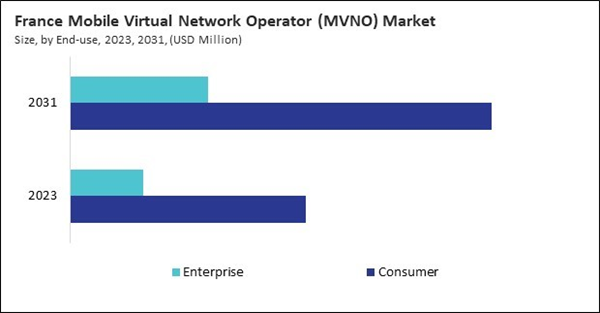The Europe Mobile Virtual Network Operator (MVNO) Market is expected to witness market growth of 7.1% CAGR during the forecast period (2024-2031).
The Germany market dominated the Europe Mobile Virtual Network Operator (MVNO) Market by country in 2023, and is expected to continue to be a dominant market till 2031; thereby, achieving a market value of $12.93 billion by 2031. The UK market is exhibiting a CAGR of 6.2% during 2024-2031. Additionally, the France market is expected to experience a CAGR of 7.9% during 2024-2031.
Beyond affordability, MVNOs excel in targeting niche demographics and underserved segments. For example, some MVNOs cater specifically to ethnic communities, offering international calling plans tailored to immigrants who need to stay connected with family abroad. Others focus on younger audiences, bundling mobile data with streaming services or gaming perks to appeal to digital natives. In the business sector, MVNOs provide enterprise solutions such as machine-to-machine (M2M) connectivity for Internet of Things (IoT) devices, enabling industries like logistics, healthcare, and agriculture to monitor assets, track shipments, or manage remote equipment efficiently.
Another key application lies in branded mobile services. Retail chains, banks, and entertainment companies have launched MVNOs to strengthen customer loyalty and diversify revenue streams. For instance, a supermarket chain might offer a mobile plan with exclusive discounts for shoppers, while a media company could bundle subscriptions with data packages. These applications highlight the adaptability of the MVNO model, allowing it to serve individual consumers and specialized industries with tailored solutions.
The increasing use of digital public services and online transactions is another key factor contributing to market growth. In 2024, 70% of EU internet users interacted with public authorities online, highlighting the shift toward digital government services. MVNOs can benefit from this trend by offering specialized mobile plans catering to digital service users, ensuring seamless access to e-government platforms. Furthermore, with 72% of EU internet users engaging in e-commerce, MVNOs can introduce data plans that support seamless online shopping experiences, secure digital payments, and customer support for e-commerce platforms. Hence, the rapid digitalization of Europe’s economy and society is fuelling demand for reliable, affordable, and data-driven mobile services.
The Germany market dominated the Europe Mobile Virtual Network Operator (MVNO) Market by country in 2023, and is expected to continue to be a dominant market till 2031; thereby, achieving a market value of $12.93 billion by 2031. The UK market is exhibiting a CAGR of 6.2% during 2024-2031. Additionally, the France market is expected to experience a CAGR of 7.9% during 2024-2031.
Beyond affordability, MVNOs excel in targeting niche demographics and underserved segments. For example, some MVNOs cater specifically to ethnic communities, offering international calling plans tailored to immigrants who need to stay connected with family abroad. Others focus on younger audiences, bundling mobile data with streaming services or gaming perks to appeal to digital natives. In the business sector, MVNOs provide enterprise solutions such as machine-to-machine (M2M) connectivity for Internet of Things (IoT) devices, enabling industries like logistics, healthcare, and agriculture to monitor assets, track shipments, or manage remote equipment efficiently.
Another key application lies in branded mobile services. Retail chains, banks, and entertainment companies have launched MVNOs to strengthen customer loyalty and diversify revenue streams. For instance, a supermarket chain might offer a mobile plan with exclusive discounts for shoppers, while a media company could bundle subscriptions with data packages. These applications highlight the adaptability of the MVNO model, allowing it to serve individual consumers and specialized industries with tailored solutions.
The increasing use of digital public services and online transactions is another key factor contributing to market growth. In 2024, 70% of EU internet users interacted with public authorities online, highlighting the shift toward digital government services. MVNOs can benefit from this trend by offering specialized mobile plans catering to digital service users, ensuring seamless access to e-government platforms. Furthermore, with 72% of EU internet users engaging in e-commerce, MVNOs can introduce data plans that support seamless online shopping experiences, secure digital payments, and customer support for e-commerce platforms. Hence, the rapid digitalization of Europe’s economy and society is fuelling demand for reliable, affordable, and data-driven mobile services.
List of Key Companies Profiled
- Deutsche Telekom AG
- Verizon Communications Inc.
- AT&T Inc.
- Boost Mobile
- Consumer Cellular, Inc.
- Red Pocket
- Lyca Mobile
- FreenetAG
Market Report Segmentation
By Contract Type
- Prepaid MVNO
- Postpaid MVNO
By End-use
- Consumer
- Enterprise
By Service Type
- 4G MVNO
- 5G MVNO
- Other Service Type
By Operational Model
- Full MVNO
- Reseller MVNO
- Service Operator MVNO
By Type
- Discount
- Migrant
- Retail
- Telecom
- M2M
- Roaming
- Media
- Other Type
By Country
- Germany
- UK
- France
- Russia
- Spain
- Italy
- Rest of Europe
Table of Contents
Chapter 1. Market Scope & Methodology
Chapter 2. Market at a Glance
Chapter 3. Market Overview
Chapter 4. Europe Mobile Virtual Network Operator (MVNO) Market by Contract Type
Chapter 5. Europe Mobile Virtual Network Operator (MVNO) Market by End-use
Chapter 6. Europe Mobile Virtual Network Operator (MVNO) Market by Service Type
Chapter 7. Europe Mobile Virtual Network Operator (MVNO) Market by Operational Model
Chapter 8. Europe Mobile Virtual Network Operator (MVNO) Market by Type
Chapter 9. Europe Mobile Virtual Network Operator (MVNO) Market by Country
Chapter 10. Company Profiles
Companies Mentioned
- Deutsche Telekom AG
- Verizon Communications Inc.
- AT&T Inc.
- Boost Mobile
- Consumer Cellular, Inc.
- Red Pocket
- Lyca Mobile
- FreenetAG
Methodology

LOADING...









